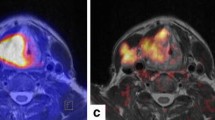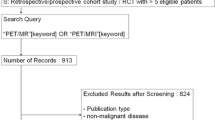Abstract
Introduction
Hybrid imaging systems providing morphological and functional data in a single session have been available for oncological imaging for some time. So far, computed tomography (CT) has been the morphological method-of-choice for inclusion into these hybrid imaging systems. However, recently, research has focused on hardware-based fusion of function with magnetic resonance imaging (MRI) rather than CT.
Objectives
Now that the first head-only positron emission tomography (PET)/MRI systems have been installed and whole-body systems are to be expected in the near future, potential indications in clinical oncology have to be addressed.
Discussion
This article discusses potential indications of PET/MRI in whole-body oncology imaging. Potential advantages and disadvantages compared with currently available hybrid imaging systems will be reviewed.








Similar content being viewed by others
References
Haberkorn U, Schoenberg SO. Imaging of lung cancer with CT, MRT and PET. Lung Cancer 2001;34(Suppl 3):S13–23.
Hoh CK. Clinical use of FDG PET. Nucl Med Biol 2007;34(7):737–42.
Collins CD. PET/CT in oncology: for which tumours is it the reference standard? Cancer Imaging 2007;7(Spec No A):S77–87.
Antoch G, et al. Accuracy of whole-body dual-modality fluorine-18-2-fluoro-2-deoxy-d-glucose positron emission tomography and computed tomography (FDG-PET/CT) for tumor staging in solid tumors: comparison with CT and PET. J Clin Oncol 2004;22(21):4357–68.
Freudenberg LS, et al. Value of (124)I-PET/CT in staging of patients with differentiated thyroid cancer. Eur Radiol 2004;14(11):2092–8.
Freudenberg LS, et al. Whole-body fluorine-18 fluordeoxyglucose positron emission tomography/computed tomography (FDG-PET/CT) in staging of advanced uveal melanoma. Surv Ophthalmol 2004;49(5):537–40.
Bar-Shalom R, et al. Clinical performance of PET/CT in evaluation of cancer: additional value for diagnostic imaging and patient management. J Nucl Med 2003;44(8):1200–9.
Pichler BJ, Judenhofer MS, Pfannenberg C. Multimodal imaging approaches: PET/CT and PET/MRI. Handb Exp Pharmacol 2008;(185 Pt 1):109–32.
Pichler BJ, Judenhofer MS, Wehrl HF. PET/MRI hybrid imaging: devices and initial results. Eur Radiol 2008;18(6):1077–86.
Pichler BJ, et al. Positron emission tomography/magnetic resonance imaging: the next generation of multimodality imaging? Semin Nucl Med 2008;38(3):199–208.
Pauls S, et al. Improved non-invasive T-staging in non-small cell lung cancer by integrated 18F-FDG PET/CT. Nuklearmedizin 2007;46(1):9–14. quiz N1–2.
Babin E, et al. PET/CT for assessing mandibular invasion by intraoral squamous cell carcinomas. Clin Otolaryngol 2008;33(1):47–51.
Veit-Haibach P, et al. Diagnostic accuracy of colorectal cancer staging with whole-body PET/CT colonography. JAMA 2006;296(21):2590–600.
Lee BY, et al. Various image findings of skeletal muscle metastases with clinical correlation. Skeletal Radiol 2008;37:923–8.
Shah GV, et al. New directions in head and neck imaging. J Surg Oncol 2008;97(8):644–8.
Fahlbusch R, Samii A. A review of cranial imaging techniques: potential and limitations. Clin Neurosurg 2007;54:100–4.
Van Goethem M, et al. Magnetic resonance imaging in breast cancer. Eur J Surg Oncol 2006;32(9):901–10.
Willatt JM, et al. MR Imaging of hepatocellular carcinoma in the cirrhotic liver: challenges and controversies. Radiology 2008;247(2):311–30.
Ba-Ssalamah A, et al. Magnetic resonance imaging of liver malignancies. Top Magn Reson Imaging 2007;18(6):445–55.
King AD, et al. The impact of 18F-FDG PET/CT on assessment of nasopharyngeal carcinoma at diagnosis. Br J Radiol 2008;81(964):291–8.
Heusner TA, et al. Whole-body PET/CT-mammography for staging breast cancer: initial results. Br J Radiol 2008; 81(969):743–8.
Heusner TA, et al. Breast cancer staging in a single session: whole-body PET/CT mammography. J Nucl Med 2008;49:1215–2.
Maderwald S, et al. To TOF or not to TOF: strategies for non-contrast-enhanced intracranial MRA at 7 T. Magma 2008;21(1–2):159–67.
Antoch G, et al. Whole-body dual-modality PET/CT and whole-body MRI for tumor staging in oncology. JAMA 2003;290(24):3199–206.
Schmidt GP, et al. Comparison of high resolution whole-body MRI using parallel imaging and PET-CT. First experiences with a 32-channel MRI system. Radiologe 2004;44(9):889–98.
Deslauriers J, Gregoire J. Clinical and surgical staging of non-small cell lung cancer. Chest 2000;117(4 Suppl 1):96S–103S.
Staples CA, et al. Mediastinal nodes in bronchogenic carcinoma: comparison between CT and mediastinoscopy. Radiology 1988;167(2):367–72.
Turkington TG, et al. Accuracy of surface fit registration for PET and MR brain images using full and incomplete brain surfaces. J Comput Assist Tomogr 1995;19(1):117–24.
Barentsz JO, Futterer JJ, Takahashi S. Use of ultrasmall superparamagnetic iron oxide in lymph node MR imaging in prostate cancer patients. Eur J Radiol 2007;63(3):369–72.
Saksena MA, Saokar A, Harisinghani MG. Lymphotropic nanoparticle enhanced MR imaging (LNMRI) technique for lymph node imaging. Eur J Radiol 2006;58(3):367–74.
Squillaci E, et al. Staging of colon cancer: whole-body MRI vs. whole-body PET-CT-initial clinical experience. Abdom Imaging. 2008; in press.
Schmidt GP, et al. Comprehensive imaging of tumor recurrence in breast cancer patients using whole-body MRI at 1.5 and 3 T compared to FDG-PET-CT. Eur J Radiol 2008;65(1):47–58.
Pfannenberg C, et al. Prospective comparison of 18F-fluorodeoxyglucose positron emission tomography/computed tomography and whole-body magnetic resonance imaging in staging of advanced malignant melanoma. Eur J Cancer 2007;43(3):557–64.
Schmidt GP, et al. Screening for bone metastases: whole-body MRI using a 32-channel system versus dual-modality PET-CT. Eur Radiol 2007;17(4):939–49.
Eustace SJ, et al. Whole-body MR imaging. Practical issues, clinical applications, and future directions. Magn Reson Imaging Clin N Am 1999;7(2):209–36.
Antoch G, et al. Assessment of liver tissue after radiofrequency ablation: findings with different imaging procedures. J Nucl Med 2005;46(3):520–5.
Kleis M, et al. Diagnostic value of PET/CT for the staging and restaging of pediatric tumors. Eur J Nucl Med Mol Imaging. 2008; in press.
Conflict of interest
There are no conflicts of interest for any of the authors.
Author information
Authors and Affiliations
Corresponding author
Rights and permissions
About this article
Cite this article
Antoch, G., Bockisch, A. Combined PET/MRI: a new dimension in whole-body oncology imaging?. Eur J Nucl Med Mol Imaging 36 (Suppl 1), 113–120 (2009). https://doi.org/10.1007/s00259-008-0951-6
Published:
Issue Date:
DOI: https://doi.org/10.1007/s00259-008-0951-6




